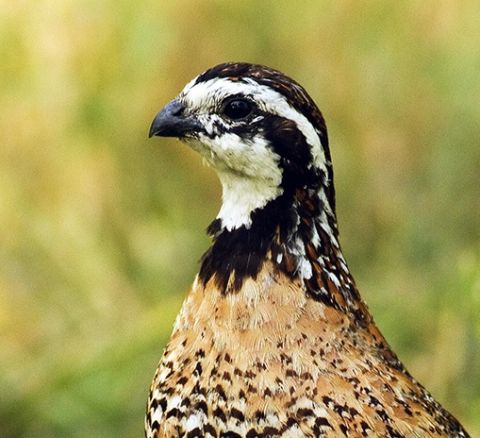
Effects of Hurricane Bret on Northern Bobwhite Survival in South Texas

Natural disasters such as hurricanes are unpredictable, devastating phenomena. Hurricanes can generate winds 200 km/hr and torrential rain at a rate of 10 cm/hr. While their impact on physical structures (e.g., buildings, trees, etc.) may be readily assessed, the effects of hurricanes on wildlife remain obscure and relatively unknown. A few studies have reported the impacts of hurricanes on wildlife, namely wild turkeys (Meleagris gallopavo; Baumann et al. 1996) and white-tailed deer (Odocoileus virginianus; Labisky et al. 1999). However, to our knowledge, the effects of hurricanes on northern bobwhites have never been reported.
Hurricane Bret made landfall on the southern coast of Texas at Kennedy County on 22 August 1999 (National Weather Service, Corpus Christi, Texas). The hurricane was classified as a Category 4 on the SaffirSimpson Scale with peak winds of 224 km/hr. The hurricane deposited approximately 64 cm of rain in some coastal locations, but weakened as it moved westward over land.
The eye of Hurricane Bret passed over Brooks County where a radiotelemetry study on bobwhite population ecology has been ongoing since August 1998. We report the effects of Hurricane Bret on bobwhite survival based on our radiomarked population of bobwhites.
The study area is within the Rio Grande Plains ecoregion of Texas (Gould 1975). The vegetation for the ecoregion is characterized as a South Texas mixedbrush community (Scifres 1980:30). Vegetation specific to the study area consists predominantly of honey mesquite (Prosopis glandulosa), huisache (Acacia smallii), granjeno (Celtis pallida), live oak (Quercus virginiana), and pricklypear cactus (Optuntia lindheimeri). Predominant forbs include croton (Croton spp.), sunflower (Helianthus annuus), dayflower (Commelina erecta), and partridge pea (Chamaecrista fasciculata). Predominant grasses include little bluestem (Schizachyrium scoparium), paspalum (Paspalum spp.), three awn (Aristida spp.), gulf cordgrass (Spartina spartinae), King Ranch bluestem (Bothriochloa ischaemum), Kleberg bluestem (Dichanthium annulatum), sandbur (Cenchrus incertus), red lovegrass (Eragrostis secundiflora), and buffelgrass (Pennisetum ciliare).
Climatic conditions are classified as semi-arid, subhumid and are characterized by a high rate of evaporation (National Cooperative Soil Survey 1987). The months of May and October receive the greatest amount of precipitation (8.6–10.4 cm), and the mean annual rainfall is 57.7 cm. The 30-year mean temperature is 22 C (range 15.2–28.8 C). January is the coldest month (mean 12.2 C), and August is the hottest month (mean 29.4 C).
We captured bobwhites using standard funnel traps and night netting during spring and summer 1999 in Brooks County, Texas. Bobwhites weighing over 150 g were fitted with a 6–7 g neck-loop radio transmitter and an aluminum leg band. We monitored bobwhites using radiotelemetry at least twice weekly during spring (Mar–Apr) and thrice weekly during the nesting season (May–Aug). This allowed timely inspections of bobwhite mortalities, nest locations, and nest fate.
On the evening of 22 August 1999, Hurricane Bret moved inland, passing through Kennedy County into Brooks County. Adult bobwhites and broods were monitored prior to the hurricane on 21 August 1999. Once the hurricane had passed, we resumed monitoring on 24 August.
We compared the number of nests found during May–October of 1999 (hurricane data) with 2000 (no hurricane) to evaluate the influence of Hurricane Bret on length of the nesting season. We evaluated the effect of added moisture generated by Hurricane Bret on weather by comparing the Modified Palmer Drought Severity Index (PMDI) for these months between years. Palmer indices (Palmer 1965) use precipitation, temperature, Thornthwaite’s (1948) evapotranspiration index, runoff, soil recharge, and average regional weather conditions to quantify departures from normal weather conditions. The values for PMDI can range from 4.0 (extreme wetness) to 4.0 (extreme drought). Near normal values range from about 1.50 to 1.50. Weather data were obtained from the National Oceanic and Atmospheric Administration’s (NOAA) National Climate Data Center (http:// www.ncdc.noaa.gov).
Because of our low sample size (100 radiomarked bobwhites), we emphasize descriptive statistics. However, we used paired t-tests (Ott 1992) to analyze the change in brood size before and after the hurricane. We used Kruskal-Wallis one-way analysis of variance by ranks test (Daniel 1987) to compare brood age in days with brood fate. Statistical results are stated as (x SD). We considered results significant at 0.05.
Hurricane Bret moved over our study area during the late evening hours of 22 August 1999 depositing 45 cm of rain and producing wind gusts 160 km/ hr. Because South Texas rangeland is relatively flat (i.e., elevation ranging about 0–300 m above sea level), this resulted in large expanses of rangeland inundated 24 cm deep. During the hurricane, we were monitoring a total of 82 adult bobwhites, 15 broods, and 4 active nests being incubated.
Adult bobwhites were not severely impacted by the storm. Eleven (13%) adult bobwhites were killed. Of these 11, 4 bobwhites were killed directly from exposure to the hurricane, apparently by drowning. We found these 4 bobwhites intact, floating in standing water. The remains of the other 7 bobwhites suggested they had been depredated (i.e., body not intact but rather dismembered). However, we are unsure if the 7 depredated bobwhites were killed by the hurricane and subsequently scavenged by predators.
Read entire article HERE